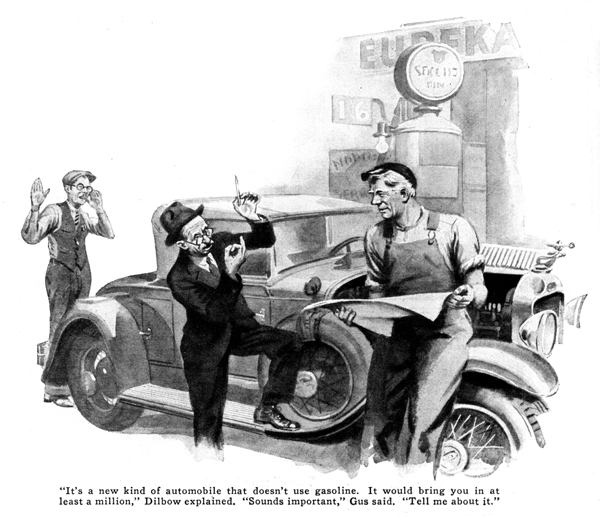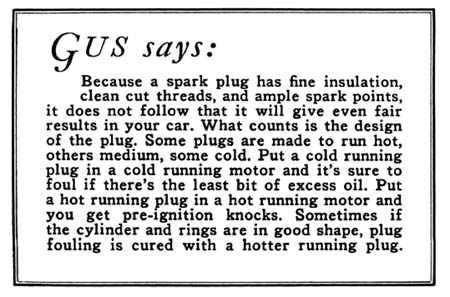October 1932
How a Car's Ammeter Can Warn of...
IGNITION TROUBLE
by Martin Bunn

"Want to make a millions dollars?"
Gus Wilson, veteran auto mechanic and half owner of the Model Garage, pulled his head from under the hood of the car on which he was working.
"Hello, Pete," he said, "What's the big idea now?"
Pete Dilbow glanced furtively about over the tops of his spectacles. "You're going to be out of a job soon!" he announced impressively, "All these cars are obstacles. They'll go straight to the junk pile soon as I get some of the little details of my latest invention worked out. It's a new kind of automobile that doesn't use gasoline. I thought since you're in this business, maybe you'd go in with me for about a tenth share. That would bring you at least a million and maybe ten times that much, if we're lucky."
Gus had been offered shares in Pete's inventions many times, but nothing had ever come of any of them.
"Sounds important, Pete," Gus told him. "Tell me about it."
At that Dilbow drew out a neatly folded sheet of brown paper and spread it out in front of Gus.
"Here," he explained, "is the design of a new kind of automobile. Learning how an ordinary car works, I had a wonderful idea. Instead of using a little motor to start the engine, I put in a motor big enough to run the car, then I put in a big generator or dynamo and a large size storage battery. The current from the battery runs the car and the dynamo keeps the battery charged. What could be simpler than that?"
"Sure is one grand idea, Pete," Gus chuckled. "There's only one trouble with it. It won't work."
"I'd like to know why not," Dilbow demanded.
"Well," Gus explained, "if it did work, that would be perpetual motion, and there isn't any such thing."
"Wouldn't this motor drive the car?" Dilbow asked.
"Wouldn't this dynamo charge the battery?" Dilbow insisted.
"It surely would if you kept it spinning at the right speed," Gus admitted.
"Then," snapped Dilbow, "what do you mean by saying the idea won't work?"
"For the simple reason," Gus explained, "that electric energy is just like water power or steam power or any other kind of power. It takes more power to pump water up hill into a tank than you can get back again by letting the water run down through a turbine.
"What do you think would happen if you made an auto like that drawing? When you turned on the juice, the car would start because current would flow through the motor, but if you put in a dynamo or generator big enough to make as much current as the motor uses, it would take more power to drive it than the motor would produce. The car would start all right, but the minute the generator cut in, it would stop as though you'd slammed on the brakes."
"If that's so," Dilbow interrupted, "then how do they get away with such small generators on automobiles? Isn't that generator," he added, pointing to the one in the car on which Gus had been working, "as small as the self-starter and doesn't the self-starter motor have power enough to turn over both the engine and the generator at the same time? And doesn't it keep the battery charged?"
"Listen, mister," Gus said, "you can't judge a book by its cover. And you can't judge how much power a generator will take or a motor will give by its size.
"The self-starter motor on a car is a specified job. It has to develop as much as a half horse power or more for just a few seconds of time and it has to do it on only six volts of electrical pressure. To get that result, the armature is wound with solid copper bars and the field with a few turns of heavy copper ribbon. Then there are four copper brushes with a wide commutator. When you press the starter button, the juice flows through the starter motor in a regular flood. Maybe as much as three or four hundred amperes go shooting through the starter motor windings for the fraction of a second it takes to 'break loose' a cold engine. Even after the crankshaft starts to turn, maybe seventy-five to a hundred and fifty amperes keep on flowing until the ignition takes hold. No starter motor could stand that load for long. The only thing that keeps it from burning up is the fact that it only has to run for a few seconds at a time.
"Now the generator is a different proposition. It's on the job as long as the engine is running above idling speed. So it's designed to produce not over eighteen or twenty amperes and it keeps the battery charged only because it runs a lot longer than the starter motor. If you tried to make a regular size generator produce more current than about twenty amperes, it would soon burn out.
"Mechanically, too, there are differences. The bearings on a starter motor are pretty crude because they don't have to stand steady running. Generator bearings, being made for continuous use, are much more durable.
"The copper brushes needed to cut down the resistance and let lots of current through the self starter motor windings are not nearly as good for steady use as the graphite carbon brushes used in the generator."
"That reminds me," Dilbow cut in, "The self starter on my old car doesn't always work. Sometimes when I step on the pedal it turns the motor over in a sort of a rough, bumpy way. The next time, it won't stir at all. What's the matter?"
"Turn on the headlights and watch the ammeter when you step on the starter," Gus advised. "If the starter takes hold and the needle flickers to beat the band or the starter doesn't work at all and the needle stays still, probably the self-starter commutator is worn and burned so badly the brushes only make contact part of the time.
"There are other things the ammeter needle tells you about your electrical system," Gus went on. "It shows you whether or not the generator cut-out is working, besides telling you when the generator is on the job. It tells when one headlight burns out by the difference in the needle position. It shows you what happens when you move the third brush and how much to move it to get the result you want. If the motor suddenly cuts out when you're breezing along, a quick glance at the ammeter will tell you whether to look for a break in the primary ignition wiring, something gone wrong with the breaker points, a burned out condenser, or a shorted distributor head."
"How do you tell that?" Dilbow asked.
"Simple enough," Gus explained. "When the ignition system is working, it takes current and the needle shows on the discharge side. If the primary circuit is open or the breaker points have backed away so they don't touch or they're burned so badly they don't let any current through, the needle goes right back to zero. If the needle acts as usual you can be sure that the contacts are working and the trouble must be in the condenser, the high tension winding of the coil, the high tension who from the coil to the distributor, or the distributor head.
"See how this all brings you right back to this new invention of yours." Gus added, fingering the drawing. "You'd never have wasted any time on this idea if you'd figured out what the ammeter shows. It's really like a gear you could put on a water pipe to show you how much water is flowing."
"I get you," Dilbow observed. "The starter motor uses electricity by the basketful for just a few seconds and the generator puts it back, a spoonful at a time, and the only reason it works at all is because the generator is on the job all the time."
Slowly he tore the brown paper plan into long, thin strips. "I guess I won't waste any more time trying to get something for nothing!" he added.
END
L. Osbone 2019
